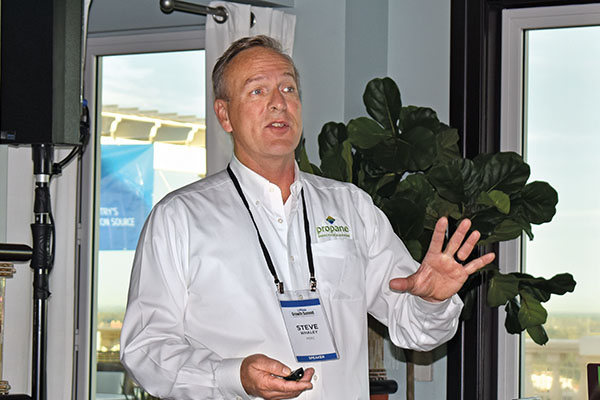PERC director plots bright future for propane autogas
Steve Whaley, director of autogas business development for the Propane Education & Research Council (PERC), helped attendees of the 2021 LP Gas Growth Summit connect the dots about why propane autogas is “Energy for Everyone.”

Steve Whaley talks autogas at the 2021 LP Gas Growth Summit. Photo by LP Gas staff
Whaley’s message: When weighing environmental impact, performance and cost, propane autogas provides better solutions than its diesel and electric competitors in a variety of markets.
“Every energy source has a path to zero [emissions], but no one has achieved it,” says Whaley. “Our message is who gets the closest to zero and for what it costs.”
Propane autogas is an ideal alternative fuel choice because it reduces harmful emissions without increasing costs or compromising efficiency and range, explains Whaley. For instance, autogas is the most cost-effective energy source to reduce smog-producing NOx emissions, yet it still offers the lowest cost of ownership of any fuel, according to PERC.
In fact, propane systems meet low-NOx standards today that diesel systems are not projected to meet until 2027. Propane also requires less maintenance compared to diesel.
“The diesel we know today requires a ton of equipment and is going to get more expensive to bring down emissions,” says Whaley.
In addition, the U.S. produces more propane than any other country in the world, another factor that makes propane autogas an attractive option for fleets from a cost and resiliency standpoint, says Whaley.
Emerging markets
Propane autogas has seen its greatest success so far in the school bus market, explains Whaley. More than 22,000 propane-powered school buses carry 1.25 million students daily across 1,000 districts and contractors, according to PERC.
As the industry looks to replicate this success in other markets, Whaley looks to what he calls the “sweet spot” for autogas: class 3-7 medium-duty vehicles, with high volumes of fuel consumption (300 to 900-plus gallons per month) and regional routes (75 to 300-plus miles per day).
Three medium-duty vehicle markets, in particular, offer high growth potential, he explains:
1. Food and beverage: Major companies in the food and beverage delivery space – including Nestlé Waters and Schwan’s – have already validated propane autogas in this market, says Whaley.
2. Paratransit: These fleets are widespread across the U.S. In fact, the Americans with Disabilities Act requires every U.S. county to provide paratransit services, explains Whaley. With an average fuel consumption of 600 gallons per month, paratransit vehicles offer propane retailers ample opportunity for gallon growth – so much so that setting one tank and managing one invoice for a paratransit fleet would yield the same margin as setting tanks for 32 new homes, Whaley emphasizes.
3. Parcel and package: In this market, 70,000 of the U.S. Postal Service’s (USPS) 92,000 routes are performed by independent contractors, which score higher with alternative fuel vehicles when bidding on USPS routes.
The average fuel consumption of vehicles in this space is 1,000 gallons per month, explains Whaley.
Operators in these markets are hearing autogas’ message of resiliency during storms and emergencies “loud and clear now,” in light of increasingly severe weather and throughout the COVID-19 pandemic, says Whaley.
Rise of renewable
When it comes to reducing emissions and competing against other energy sources in the transportation market, renewable propane is “dead-on important,” says Whaley.
To underline the urgency of a renewable component, Whaley explains that more than 50 percent of the U.S. population has asked state legislatures to pass comprehensive carbon goals.
“Unless we talk about renewable, we’re going to lose out,” he says.
Renewable propane is produced as a byproduct of renewable diesel refining. When renewable propane is mixed with renewable dimethyl ether (DME) – currently produced using waste methanol – the resulting fuel is almost carbon neutral, says Whaley.
In a comparative life cycle analysis of greenhouse gas emissions produced by propane and electric medium-duty vehicles, PERC found that the carbon intensity of one truck that runs on renewable propane is lower than that of an electric truck in every state but Vermont. When renewable propane is blended with renewable DME, the medium-duty truck’s carbon intensity is lower than electric in every state, even with a decarbonized electric grid.
“This EV-only thing has got to stop,” says Whaley.
Fortunately, he adds, the results of the study send a powerful message to regulators and policymakers.
















